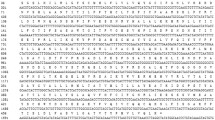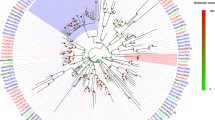Abstract
Odorant receptors are thought to play critical roles in the perception of chemosensory stimuli by insects. The primary method to address the functions of odorant receptors in insects is to use in vitro binding assays between the receptors and potential chemical stimuli. We injected MmedOrco dsRNA into the abdominal cavity of a braconid wasp, Microplitis mediator, and assayed for expression of this gene 72 h after treatment (RNAi). Quantitative real-time PCR demonstrated that the level of mRNA expression in MmedOrco dsRNA-treated M. mediator was significantly reduced (>90%) when compared with water-treated controls. Furthermore, electroantennogram (EAG) responses of M. mediator to two chemical attractants, nonanal and farnesene, were also reduced significantly (~70%) in RNAi-treated M. mediator when compared to controls. RNAi-treated M. mediator also responded by walking/flying at a lower rate to both chemicals when compared with controls in a Y-tube olfactometer bioassay, which provides direct evidence that MmedOrco plays an important role in perception of nonanal and farnesene in M. mediator.






Similar content being viewed by others
References
Amdam, G. V., Simo, Z. L., Guidugli, K. R., Norberg, K., and Omholt, S. W. 2003. Disruption of vitellogenin gene function in adult honeybees by intra-abdominal injection of double-stranded RNA. BMC Biotechnol. 3:1.
Arthur, A. P. and Mason, P. G. 1986. Life history and immature stages of the parasitoid Microplitis mediator (Hymenoptera: Braconidae), reared on the bertha armyworm, Mamestra configurata (Lepidoptera: Noctuidae). Can. Entomol. 118:487–491.
Benton, R., Saches, S., Michnick, S. W., and Vosshall, L. B. 2006. Atypical membrane topology and heteromeric function of Drosophila odorant receptors in vivo. PloS Biol. 4:240–257.
Bettencourt, R., Terenius, O., and Faye, I. 2002. Hemolin gene silencing by ds-RNA injected into Cecropia pupae is lethal to next generation embryos. Insect Mol. Biol. 11:267–271.
Boisson, B., Jacques, J. C., Choumet, V., Mattin, E., Xu, J., Vernick, K., and Bourgouin, C. 2006. Gene silencing in mosquito salivary glands by RNAi. FEBS Lett. 580:1988–1992.
Bucher, G., Scholten, J., and Klingler, M. 2002. Parental RNAi in Tribolium (Coleoptera). Curr. Biol. 12:R85–R86.
Carthew, R. W. 2001. Gene silencing by double-stranded RNA. Curr. Opin. Cell Biol. 13:244–248.
Clyne, P. J., Warr, C. G., Freeman, M. R., Lessing, D., and Kim, J. 1999. A novel family of divergent seven-transmembrane proteins: Candidate odorant receptors in Drosophila. Neuron 22:327–338.
Dykxhoorn, D. M., Novina, C. D., and Sharp, P. A. 2003. Killing the messenger: short RNAs that silence gene expression. Nat. Rev. Mol. Cell Bio. 4:457–467.
Eleftherianos, I., Marokhzal, J., Millichap, P. J., Hodgkinson, A. J., Sriboonlert, A., and Reynolds, S. E. 2006. Prior infection of Manduca sexta with non-pathogenic Escherichia coli elicits immunity to pathogenic Photo-rhabdus luminescens: roles of immune-related proteins shown by RNA interference. Insect Biochem. Mol. Biol. 36:517–525.
Fire, A., Xu, S., Montgomery, M. K., Kostas, S. A., Driver, S. E., and Mello, C. C. 1998. Potent and specific genetic interference by double-stranded RNA in Caenorhabditis elegans. Nature 391:806–811.
Gatehouse, H. S., Gatehouse, L. N., Malone, L. A., Hodges, S., Tregida, E., and Todd, J. 2004. Amylase activity in honey bee hypopharyngeal glands reduced by RNA interference. J. Apicult. Res. 43:9–13.
Ghanim, M., Kontsedalov, S., and Czosnek, H. 2007. Tissue-specific gene silencing by RNA interference in the whitefly Bemisia tabaci (Gennadius). Insect Biochem. Mol. Biol. 37:732–738.
Jones, W. D., Nguyen, T. A., Kloss, B., Lee, K. J., and Vosshall, L. B. 2005. Functional conservation of an insect odorant receptor gene across 250 million years of evolution. Curr. Biol. 15:R119–R121.
Kennerdell, J. R. and Carthew, R. W. 1998. Use of dsRNA-mediated genetic interference to demonstrate that frizzled and frizzled 2 act in the wingless pathway. Cell 95:1017–1026.
Krieger, J., Grobe-Wilde, E., Gohl, T., and Breer, H. 2005. Candidate pheromone receptors of the silkmoth Bombyx mori. Eur. J. of Neurosci. 21:2167–2176.
Krieger, J., Klink, O., Mohl, C., Raming, K., and Breer, H. 2003. A candidate olfactory receptor subtype highly conserved across different insect orders. J. Comp. Physiol. 189:519–526.
Larsson, M. C., Domingos, A. I., Jones, W. D., Chiappe, M. E., and Amrein, H. 2004. Or83b encodes a broadly expressed odorant receptor essential for Drosophila olfaction. Neuron 43:703–714.
Liu, S. -H., Ding, Z. -P., Zhang, C. -W., Yang, B. -J., and Liu, Z. -W. 2010. Gene knockdown by intro-thoracic injection of double-stranded RNA in the brown planthopper, Nilaparvata lugens. Insect Mol. Biol. 40:666–671.
Livak, K. J. and Schmittgen, T. D. 2001. Analysis of relative gene expression data using real-time quantitative PCR and the 2 -ΔΔCT Method. Methods. 25:402–408.
Maleszka, J., Fore, S., Saint, R., and Maleszka, R. 2007. RNAi-induced phenotypes suggest a novel role for a chemosensory protein CSP5 in the development of embryonic integument in the honeybee (Apis mellifera). Dev. Genes Evol. 217:189–196.
Meister, G. and Tuschl, T. 2004. Mechanisms of gene silencing by double-stranded RNA. Nature 431:343–349.
Melo, A. C. A., Rutzler, M., Pitts, R. J., and Zwiebel, L. J. 2004. Identification of a chemosensory receptor from the yellow fever mosquito, Aedes aegypti, that is highly conserved and expressed in olfactory and gustatory organs. Chem. Senses 29:403–410.
Misquitta, L. and Paterson, B. M. 1999. Targeted disruption of gene function in Drosophila by RNA interference (RNA-i): a role for nautilus in embryonic somatic muscle formation. Proc. Natl. Acad. Sci. USA. 96:1451–1456.
Narasimhan, S., Montgomery, R. R., Deponte, K., Tschudi, C., Marcantonil, N., Anderson, J. F., Sauer, J.R., Cappello, M., Kantor, F. S., and Fikrig, E. 2004. Disruption of Ixodes scapularis anticoagulation by using RNA interference. Proc. Natl. Acad. Sci. USA. 101:1141–1146.
Nichols, A. S. and Luetje, C. W. 2010. Transmembrane segment 3 of Drosophila melanogaster odorant receptor subunit 85b contributes to ligand-receptor interactions. J. Biol. Chem. 285: 11854–11862.
Pitts, R. J., Fox, A. N., and Zwiebel, L. J. 2004. A highly conserved candidate chemoreceptor expressed in both olfactory and gustatory tissues in the malaria vector Anopheles gambiae. Proc. Natl. Acad. Sci. USA. 101:5058–5063.
Rajagopal, R., Sivakumar, S., Agrawal, N., Malhotra, P., and Bhatnagar, R. K. 2002. Silencing of midgut aminopeptidase N of Spodoptera litura by double-stranded RNA establishes its role as Bacillus thuringiensis toxin receptor. J. Biol. Chem. 277:46849–46851.
Sato, K., Pellegrino, M., Nakagawa, T., Vosshall, L. B., and Touhara, K. 2008. Insect olfactory receptors are heteromeric ligand-gated ion channels. Nature 452:1002–1006.
Shenefelt, R. D. 1973. Braconidae: Macrogasterinae and Ichneutinae, pp. 750–751, in V. V. Jones and R. D. Shenefelt (eds.). Hymenopterum Catalogus Nova Edito. W. Junk Press, Gravenhage, Holland.
Smart, R., Kiely, A., Beale, M., Vargas, E., and Carraher, C. 2008. Drosophila odorant receptors are novel seven transmembrane domain proteins that can signal independently of heterotrimeric G proteins. Insect Biochem. Molec. 38:770–780.
Tomoyasu, Y. and Denell, R. E. 2004. Larval RNAi in Tribolium (Coleoptera) for analyzing adult development. Dev. Genes Evol. 214:575–578.
Turner, C. T., Davy, M. W., Macdiarmid, R. M., Plummer, K. M., Brich, N. P., and Newcomb, R. D. 2006. RNA interference in the light brown apple moth, Epiphyas postvittana (Walker) induced by double-stranded RNA feeding. Insect Mol. Biol. 15:383–391.
Vlachou, D., Schlegelmilch, T., Christophides, G. K., and Kafatos, F. C. 2005. Functional genomic analysis of midgut epithelial responses in Anopheles during Plasmodium invasion. Curr. Biol. 15:1185–1195.
Vosshall, L. B., Amrein, H., Morozov, P. S., Rzhetsky, A., and Axel, R. 1999. A spatial map of olfactory receptor expression in the Drosophila antenna. Cell 96:725–736.
Vosshall, L. B., Wong, A. M., and Axel, R. 2000. An olfactory sensory map in the fly brain. Cell 102:147–159.
Wicher, D., Schafer, R., Bauernfeind, R., Stensmyr, M. C., and Heller, R. 2008. Drosophila odorant receptors are both ligand-gated and cyclic-nucleotide-activated cation channels. Nature 452:1007–1011.
Yu, H. -L., Zhang, Y. -J., Kris, A. -G., Wu, K. -M., Gao, X. -W., and Guo, Y. -Y. 2010. Electrophysiological and behavioral responses of Microplitis mediator (Hymenoptera: Braconidae) to caterpillar-induced volatiles from cotton. Environ. Entomol. 39:600–609.
Syed, Z., Kopp, A., Kimbrell, D. A., and Leal, W. S. 2010. Bombykol receptors in the silkworm moth and the fruit fly. Proc. Natl. Acad. Sci. USA. 107:9436–9439.
Zhang, S., Zhang, Y. -J., Su, H. -H., Gao, X. -W., and Guo, Y. -Y. 2009. Gene cloning and tissue-specific expression of an olfactory receptor in Microplitis mediator (Hymenoptera: Braconidae). Scientia Agricultura Sinica 42:1639–1645 (in Chinese).
Zhao, Y. -Y., Liu, F., Yang, G., and You, M. -S. 2010. PsOr1, a potential target for RNA interference-based pest management. Insect Mol. Biol. 20:97–104.
Acknowledgments
This study was funded by the China National “973” Basic Research Program (Grant No. 2012CB114104), the National Natural Science Foundation of China (Grant No. 30871640, 31171858), and the International Cooperation and Exchange Foundation of NSFC-RS (Grant No. 31111130203). We also thank Dr. Xiangbing Yang of Northwest A & F University for the review of an earlier version of this manuscript.
Author information
Authors and Affiliations
Corresponding author
Rights and permissions
About this article
Cite this article
Li, KM., Ren, LY., Zhang, YJ. et al. Knockdown of Microplitis mediator Odorant Receptor Involved in the Sensitive Detection of Two Chemicals. J Chem Ecol 38, 287–294 (2012). https://doi.org/10.1007/s10886-012-0085-y
Received:
Revised:
Accepted:
Published:
Issue Date:
DOI: https://doi.org/10.1007/s10886-012-0085-y




